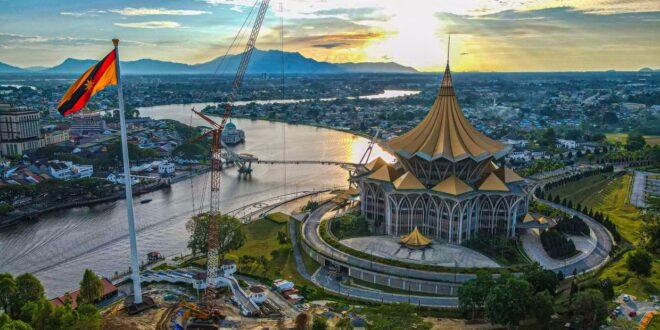THE hype surrounding Sarawak is not new. It is sitting on a growing pot of gold thanks to higher oil and gas (O&G)-related royalties from the federal government.
The state is taking some audacious bets. Using its vast green energy resources — read hydropower — it is seeking to become one of the world’s largest producers of green hydrogen.
Sarawak also wants to attract industries such as semiconductors and other high-level manufacturing.
But how will all this pan out? Is the state hampered by its poor infrastructure and the lack of a skilled workforce?
More importantly, is it planning things out well and spending its money in the best way possible to secure its future?
Take the case of green hydrogen. Though hailed by some quarters as a futuristic energy source, it is yet to be proven to be viable or applicable in everyday use.
Sarawak’s immense green energy puts it in a top position to power electrolysers that produce green hydrogen. While extensive research and development (R&D) is ongoing in many reputable locations worldwide, there are risks and the financial returns are unclear.
The good news is that Sarawak is venturing into green hydrogen with top Japanese and Korean consortia. What isn’t known though is how much the state will be investing into these ventures, as well as the risks and potential returns on investment.
It is also difficult to see how these investments will lead to the trickle- down effect of economic well-being that the Sarawak leadership is set on achieving.
Universiti of Malaysia Sarawak honorary professor Datuk Dr Madeline Berma points out that while Sarawak is the fourth-biggest contributor to Malaysia’s GDP, it has one of the highest incidences of poverty in the country.
“The state needs to be more aggressive and develop ‘game-changing’ poverty alleviation policies,” she opines.
Another challenge is manpower-related. Dabbling into hydrogen requires a lot of technical and R&D expertise. While Sarawak does have a decent base of O&G engineers, it may not be so easy for them to transition into this new field.
Manpower planning
Sarawak Premier Tan Sri Abang Johari Tun Openg is on the right track when he says that his priority is to create a well-trained and knowledgeable human capital with a world-class education system.
He acknowledges that the state’s wealth of natural resources alone won’t guarantee complete success. New international schools using the Cambridge syllabus and free tertiary education at a number of universities in the state have been announced.
While these are big steps in the right direction, more needs to be done. Sarawak ought to follow Singapore’s model of manpower planning for the future, which began in the 1970s.
What is needed is more expertise at government level, sourced from the private sector, to plan out and execute its manpower planning. It would also do good to attract more highly skilled foreign talent into the state.
Profession Dr Awang Azman Azman Pawi from Universiti Malaya in his op-ed suggests that Sarawak needs to have more collaborations with educational institutions and needs to have more incentives for skilled workers.
Spending wisely
Sarawak is in a sweet spot today, with its coffers said to be ballooning close to RM40bil in reserves. The state has been writing cheques to set up enterprises or acquire assets it thinks it needs.
In 2020, TV Sarawak (TVS) was launched to fulfil a purported need for better coverage of activities in the state. This enterprise continues to be funded by the state to the tune of around RM50mil a year, sources say.
Sarawak is also in the process of buying up to 30% of Affin Bank Bhd and taking control of Bintulu Port and MASWings. The state is spending a lot on infrastructure too, with millions being spent to build roads in rural areas and upgrade its water supply network.
But the worry is, is there sufficient thinking and planning being done to ensure that the state is getting the best bang for its buck? Is it also missing out on low hanging fruit?
Tan Kee Hian, a senior international business and policy advisor, reckons that what Sarawak needs is substantially more technocrats in its leadership.
“It’s fine to get into New Age sectors but for hydrogen, what exactly is the state’s strategy, what are the risks and returns? Is it the best use of the state’s resources at this point?” he questions.
Sibu-born Tan, who attended Imperial College London on a Shell scholarship in the 1970s and Harvard Business School in the 1980s, points out that Sarawak’s O&G success was largely driven by technological know-how from Shell.
“Rather than venturing into something that is so new, unproven and risky like hydrogen and semiconductors, Sarawak should prioritise lower hanging fruits with better strategic fit, such as agro-tech,” he opines.
With abundant land — and collaborations with agri-tech partners from countries such as Thailand, Taiwan, Denmark, Holland and Singapore, which is an emerging regional food hub — Sarawak could easily create a new strategic and sustainable sector and become a big player in this ‘proven’ market space amidst the global food security crisis, Tan points out.
Robert Lau, a lawyer and former Sarawakian senator concurs. “Whether Sarawak will succeed in its ambitious plans today will depend on how well its plans are thought out and executed.
“The vision has to be clear, supported by a comprehensive integrated development strategy and implementation plan. The linkages between the desired outcome and the vision, policies and plan have to be robust and logical,” he says.
This article first appeared in Star Biz7 weekly edition.
 BeritaKini.biz Berita Viral Terkini di Malaysia
BeritaKini.biz Berita Viral Terkini di Malaysia





